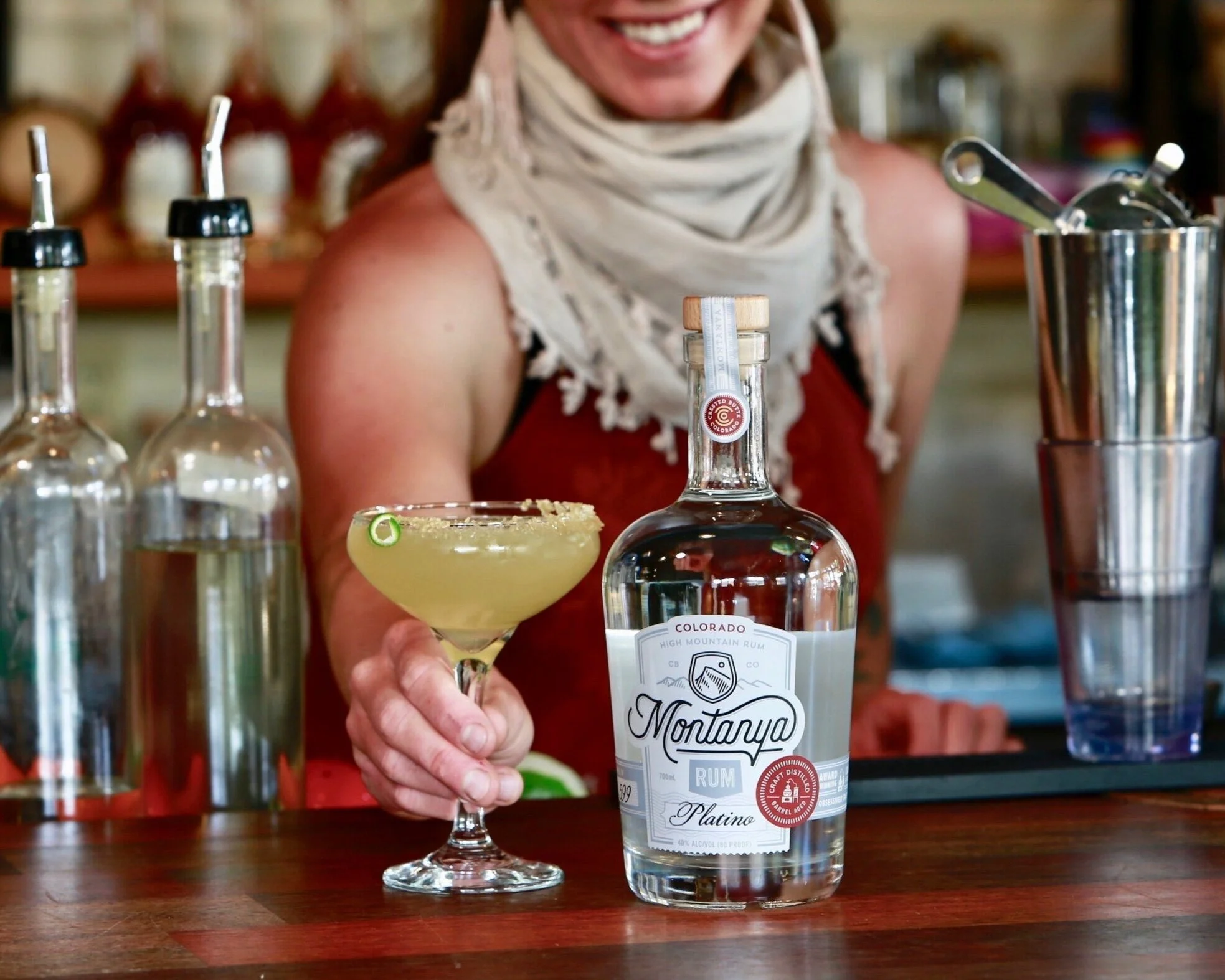A Closer Look at the Classic Daiquiri
We love a good Daiquiri at Montanya, and it’s also a cocktail of choice for our founder and owner Karen Hoskin. When it comes to cocktails that are simple, well balanced and elegant, the Daiquiri is hard to match. Here we take a closer look at the cocktail’s origins, some of Karen’s tips for making a great Daiquiri, and some variations we love almost as much as the original.
A Classic Daiquiri at the Montanya Tasting Room
A Brief History of the Daiquiri
If you first tried a Daiquiri on spring break or during college, there’s a good possibility it came frozen and not shaken—a boozy slushy in a cup, with several flavors available but most notably strawberry. While frozen drinks most certainly have their time and place, we’re partial to the predecessor: lime, simple syrup and rum, shaken with ice and strained into a coupe glass.
This more traditional form of the cocktail is often traced back to two men: American engineer Jennings Cox, who was stationed in Cuba after the Spanish-American war, and U.S. naval officer Admiral Lucius W. Johnson. According to lore, during the late 1890s, Cox ran out of gin during a cocktail party and served his guests a combination of the local rum, limes and sugar. A hit, he and his friends later named it the Daiquiri (after the port town where the U.S. first invaded Cuba). Johnson is credited with bringing the cocktail back to the States by introducing it to the bartenders at the Army & Navy Club in Washington DC in 1909.
(It is worth noting, however, that Cox didn’t necessarily invent the Daiquiri so much as adapt it from local traditions. Some combination of the same ingredients had long been enjoyed in the Caribbean already, and the British navy cut sailor’s rum rations with water and citrus well before the famed cocktail party.)
The Daiquiri is also well associated with the writer Ernest Hemingway, who is said to have fallen in love with it at El Floridita in Havana (a cocktail bar still famous for its daiquiris). One version of the cocktail even bears Hemingway’s name, featuring grapefruit juice and maraschino cherry liqueur. (It’s believed that Hemingway regularly requested modifications because his diabetes necessitated less sugar than the original recipe.) It was also at El Floridita that bartender Constantino Ribalaigua Vert first started adding crush iced during the 1930s, leading the way for what became popular during the 40s and 50s (and still is today): frozen daiquiris.
And while we might not serve the frozen variation in our Tasting Room, we are partial to a few ice chips floating on top. (Who says you can’t have the best of both worlds?)
Tips for Making a Great Classic Daiquiri
The recipe for a Classic Daiquiri is deceptively simple: 2.5 oz Montanya Platino, 1 fresh lime, juiced, and .5 - 1 oz. simple syrup depending on your preference for sweetness. Shake with ice and strain into a coupe glass. If you caught Karen’s virtual happy hour with Spirit Hub, however, you know this is more of a starting point and the details matter. Here are some of her tips for making a great Daiquiri and adapting it to your tastes:
Adjust ingredients to taste. One of the Daiquiri’s virtues is its adaptability. If you don’t like a strong alcohol taste, you might use less rum or avoid the over proof rum many people love like Smith and Cross or Rum Fire. And if, like Karen, you prefer your cocktails less sweet, you can cut the simple syrup to half an ounce or even less. Enjoy sugar or salt rims? Feel free to dress it up. (The Daiquiri is a predecessor to the Margarita, after all, which is know for its salt rim.)
Pick your limes carefully. Depending on the season or country of origin, the quality of limes can vary. When you hold a good lime, you can squeeze it—it isn’t dry or hard. And when you slice it open, it should be bright green rather than yellow or desiccated. If you do find that your limes are drier than expected, feel free to use more. We’ll sometimes use a lime and a half if they aren’t as juicy as we’d like. If the limes are bitter, you may want to add more simple syrup or a touch of citrus bitters.
Shaking thoroughly mixes the ingredients, chills the cocktail and helps balance the cocktail.
Use a squeezer to juice the lime and a jigger to measure the rum. If you’re still stocking your home bar, you can always improvise. But using a squeezer for your lime means you’ll capture every bit of the valuable juice, and measuring your alcohol will allow you to make a well balanced cocktail that isn’t dominated by one ingredient.
Don’t shortchange the shake. Shaking the cocktail thoroughly does two things: properly chills the drink and melts some of the ice, helping to balance the cocktail and keep it cold the whole time you are drinking it.
Consider a lime twist to garnish. While certainly not required, twisting a small piece of lime rind and placing it on the rim adds two things to a Daiquiri: visual appeal and a pleasant aroma. Karen loves to use garnishes as a way to enhance the flavors, often selecting a garnish whose scent matches or complements the predominant flavor of the cocktail. (One new trend in the making of daiquiris is a dried lime slice garnish. Keep in mind that this is more of an economical decision, to save money on fresh limes. With no scent or flavor, it doesn’t add to your enjoyment of the cocktail.)
Daiquiri Recipes and Variations on the Classic
Here are four favorite recipes from our online collection:
Classic Daiquiri
Our take on the classic using Montanya Platino. We’ve also been known to use a combination of Platino and Oro—while the addition of a dark rum technically strays away from the daiquiri, it’s a flavorful combination that sometimes fits the bill. Find the recipe here.
Hemingway Daiquiri
Luxardo or Leopold Brother's Maraschino Liqueur and fresh grapefruit dress up this version of the Daiquiri enjoyed by the famous writer himself.
Ti Exclusiva or Ti Valentia
If you’re a cocktail purist, you’ll know these technically aren’t daiquiris. These recipes are actually a nod to the Ti Punch, a popular cocktail in the French speaking islands of the Caribbean. Like the Daiquiri, a Ti Punch combines rum with lime and sugar but uses a French agricole style rum instead of a white rum. We don’t make agricole style rums but enjoy these variations using our dark, longer-aged rums. They offer a nice option for cocktail-forward drinkers and those who prefer dark rums.
Basil Paradisi
This recipe isn’t so much a daiquiri as it is daiquiri inspired. We combine basil infused rum (so easy to make at home), grapefruit and lime for a refreshing and flavorful cocktail. (If we write the next great American novel, maybe it too can become as famous as the Hemingway Daiquiri?!)








